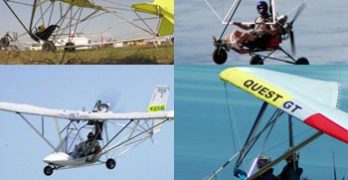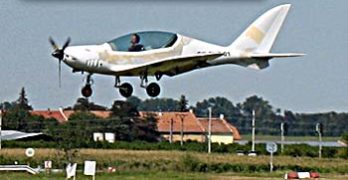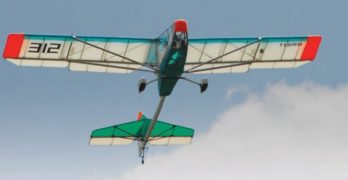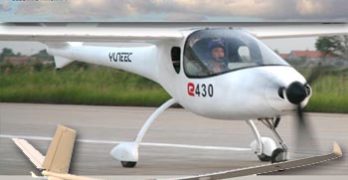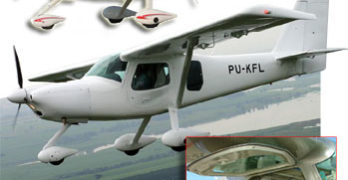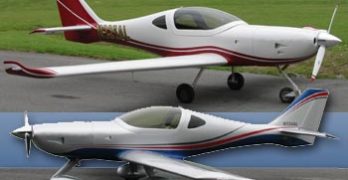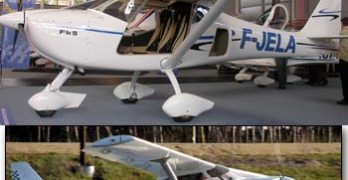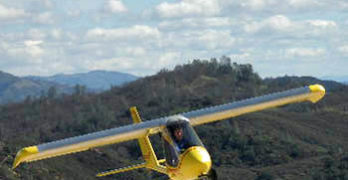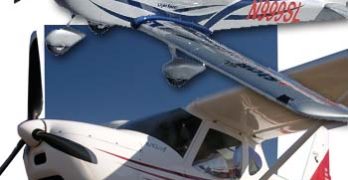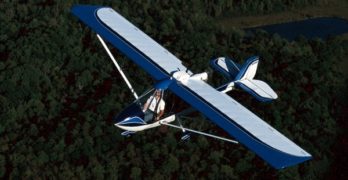Ah, sweet Part 103 ultralights. These lightest of powered aircraft have the least FAA regulation of any flying machine. A single piece of letter paper holds the entire rule. But how do you learn to safely fly a single seater? Oh, there’s the rub. *** Through January 31, 2010, two-seat ultralights converted to ELSA status may train pilots for hire. Then they must cease… maybe. Some feel that the nation lacks enough such trainers so Aero Sports Connection petitioned for an extension. Sounds reasonable. *** But what about companies that spent resources to win FAA approval? It sounds like those who played by the rules as FAA wished could miss their reward of taking over such training aircraft sales. The controversy has complications and you probably don’t want to read it all. *** But here’s what industry organization LAMA has to say: “In the 4.3 years since the first approval, 100 SLSA models have been approved.
Search Results for : Flight Design
Not finding exactly what you expected? Try our advanced search option.
Select a manufacturer to go straight to all our content about that manufacturer.
Select an aircraft model to go straight to all our content about that model.
A First Look at Two New Tandem LSA
Here come the new tandems. And I do mean new! Suspending a full flight-trial regime, U.S.-based MySky took their new MS-1 on a long maiden voyage from Daytona Beach, Florida to Oshkosh 2009. And just yesterday, the Slovak Republic-based sportShark, from Shark.Aero, took its first flight. *** Tandems seat occupants fore and aft like some existing SLSA models but that’s where the similarities end. MS-1 and sportShark are clean-sheet designs aimed at performance and comfort, where all tandems presently approved are recreational aircraft. *** Other than the composite Sky Arrow*, all other seven tandems in the SLSA List are simpler, first-generation designs. All are fabric covered. None are speedsters. (Note: You can find all these qualities for any of the 99 SLSA models using PlaneFinder 2.0.) *** One and sportShark are second-generation designs. In both cases they were created after and because of the Light-Sport rules and ASTM industry-standards certification.
Happy Birthday LSA!
By Susan Parson
Photos by H. Dean Chamberlain
It may seem like it started only yesterday, but the Sport Pilot/Light-Sport Aircraft
rule (SP/LSA) celebrates its fifth “birthday” this summer. In many families,
making a “how-tall-are-you-now” mark on the wall is a time-honored birthday
tradition. In keeping with that concept, this article reviews and celebrates the mark
SP/LSA has made since it joined the aviation family back in 2004.
My, How You’ve Grown!
In developing the SP/LSA rule, FAA’s intent
was to increase safety by closing gaps in existing
regulations, accommodate advances in technology,
provide for the manufacture of light-sport aircraft
that are safe for their intended operations, and
several other purposes. A key idea was to make it
possible for more individuals to experience sport
and recreational aviation in a manner that is not
overly burdensome, but still safe.
Today, more than 2,000 individuals have
earned sport pilot certificates, and numerous
others have earned sport pilot privileges.
Arriving from Shanghai…Electric Power Two Seater
Two Chinese delegates attended ASTM meetings in Freidrichshafen Germany in April, the first time the nation has been represented. Those reps indicated they believed ASTM acceptance in China may not be far off. Meanwhile, Shanghai-based Yuneec company is moving forward, and upward. *** Yuneec’s E430 will be featured at AirVenture along with a distinctly American design: the Flightstar Spyder (single place, Part 103-capable ultralight) fitted with a Yuneec electric motor. *** Using a 6-battery setup on their two seater, E430 expects 1.5-2 hours of flight and with such an installation, payload is a respectable 400 pounds even with a 45-foot wing span. A 10-battery setup may fly 2.25-2.5 hours. A video gives a hint to the sound level (turn your speakers up loud). *** Yuneec International announced, “The E430 is a twin seat, single engine, LSA class aircraft designed to be simple to use, easy to fly and with virtually zero vibration.
Coming Together Globally; Kolb’s Flyer SS
A Canadian design — the Pelican 700 — was reengineered into a SLSA by an American company — New Kolb Aircraft — and is being manufactured by a Brazilian company — Flyer Industria Aeronautica. Such international collaboration is becoming common. *** Kolb won approval for the Flyer SS in July (#87 on our SLSA List). Leading the SLSA project is Izek Therrien who said, “The master lines [of the Pelican] were kept. The fuselage was then rounded, enlarged and equipped with a new flight control system.” He reported 57 have been sold in South America and that a second Flyer SS will enter the USA in October.” *** Some SPLOG readers may be unfamiliar with the Kolb name, but this 30-year old brand has produced 3,000 of their popular models including the Mark III and the Kolbra. Every one until the Flyer SS has been a kit.
Lightning Fast; Arion Earns SLSA Before Sun ‘n Fun
After selling 40 aircraft under the Experimental Amateur Built (EAB) rule, Arion has now completed their SLSA approval just in the nick of time before the season-launching Sun ‘n Fun starts. Welcome to Lightning — SLSA #96 — from Arion Aircraft, which is our 69th company to enter production of Light-Sport Aircraft. *** Lightning got its start back when Jabiru-man Pete Krotje, his son Ben, plus Nick Otterback were dealers for the Spanish Esquale. That lead to the lovely low-wing Lightning though the design borrows from several light aircraft. It may sound like an organic development but the results are definitely worthy. I was highly impressed with a flight in an earlier EAB model, which did not have the speed limitations of LSA. “Extra wing area was added to bring wing loading and stall speeds into compliance with the applicable standards,” said Nick. *** Arion won approval on April 15, 2009.
FK Lightplanes New Model; Offsetting Cirrus Stall
Most American pilots don’t recognize the brand FK Lightplanes, though many do know of one of their models. Cirrus Design based their celebrated entry into Light-Sport Aircraft upon the Fk14 Polaris. This lovely low wing looks enough like a Cirrus that the Duluth, Minnesota manufacturer selected it as their platform to offer what they called the SRS. *** The producer of the best-selling SR22 felt they needed to “Cirrus-ize” the Fk14, but now with the GA industry in sharp decline the company put the SRS project on hold to focus on their Vision jet (which sells for 10X more). *** Yet FK Lightplanes also builds a handsome high-wing model, which has gone through significant refinements in more than a decade on the market. “We’ll still make our Fk9 Mark 4 [the earlier model],” said company director Peter Funk, but his company is now launching the Fk9 ELA (as in European Light Aircraft), a version that more closely matches LSA specifications.
Green Power — Earthstar’s All-Electric eGull
The hum of interest in electric-powered aircraft continues, a parallel to development of electric automobiles. Despite their woes all over the news, the auto industry is spending millions on electric power. In sharp contrast, electric airplane developments are being done on tiny budgets by entrepreneurs.
Yet enough development is happening that the German Aero show will have a show-within-a-show, the e-flight-expo. Says German publisher and co-organizer of the event with Aero management, Willi Tacke, “At this moment we have a dozen trend setting exhibitors to participate at the first e-flight-expo April, 2-5, 2009.”
I’ve written about electric projects: Electra Flyer/others and Sonex. The newest entry involves one of my all-time favorite airplanes, the Earthstar Aircraft Gull 2000. This ultra-light single seater flies efficiently on a very small wing, so when I spoke to Mark Beierle recently I got excited when he told me he’s working on the eGull.
Light-Sport Aircraft… Leading the Way Up?
Sebring was a welcome event for all who participated. Companies that stayed home may be wondering if that was the right move. With record crowds, airplane orders taken, and merchandise selling out, the Florida LSA show gave a welcome lift to a global aviation industry that’s been laying off workers by the thousands. But, besides the general good news I’ve been asked dozens of times, “What was new?” at the event. Here’s my list; details will follow in other SPLOG posts. Surely I’ll leave out some worthy aircraft (you’ll tell me, I hope, and I’ll include them). *** In no particular order…the well-proven RANS S-6 Coyote debuted as an SLSA; Urban Air’s newly certified Samba complements their lovely Lambada; FPNA’s amphibious Cape Town appeared on brand-new floats; Paradise delivered their first hand-control P-1; Remos debuted their GX 2009 with new gear and a redesigned interior; a year after its debut at Sebring ’08 CTLS displayed the first-ever Garmin 696 installation, while the avionics company announced their GDU 370 and 375 MFDs; Evektor showed their SportStar SL with a recontoured exterior; Tony and Adriel Anderson showed their Fk9 on new Baumann amphib floats; they’re teaming up for sales with Hansen Air Group, which also showed a production version of their new FA-04 Peregrine; Zenith Aircraft constantly demo flew the STOL CH-750, an upgrade from their popular 701; Cessna identified notable changes in the final Skycatcher design (a larger tail) and confirmed first deliveries in ’09; and, the K-10 from Ukraine-based Skyeton made its worldwide debut…and made a sale.
Modestly-Priced, Easy-Flying Challenger Series
For 21 Years, Quad City’s Challenger has proved a good choice.
It’s enough to create a serious case of envy among producers vying for the market the Challenger seems to own year after year. Even in 2003, a slow year for all aircraft manufacturers, Quad City Ultralight Aircraft pumped out another 120 kits. Most light-sport aviation companies would consider that an excellent performance. For Quad City, it was a down year!
The venerable company from the Quad Cities area of Iowa, near the Illinois border, has put more than 3000 aircraft in the air. Van’s Aircraft has done even better, and Quicksilver has more than 10,000 ultralights flying, but the Challenger is clearly one of the industry’s leaders. And the company has enjoyed the same leadership since it was founded more than two decades ago.
Despite this success, Quad City maneuvers rather quietly. Last year the company celebrated 20 years of operation, yet many ultralighters and most aviators were unaware of the accomplishment.
- « Previous Page
- 1
- …
- 107
- 108
- 109
- 110
- 111
- …
- 147
- Next Page »


